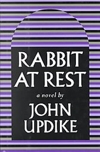Writing for the Times Union (“Rabbit had quite the run”), Casey Seiler shares with readers his thoughts after reading Rabbit at Rest again. And his first paragraph summation of just a few of the topics Updike covers in the 1990 novel—Donald Trump, Oprah Winfrey, Bill Cosby, sexual misconduct, substance abuse, junk food—seem proof enough of the novel’s continued relevancy.

Seiler adds, “For Updike’s Rabbit, 1989 is a year of entropy in which his lifetime of unquenchable appetites presents him with a past-due bill. Reading it today, you get the strange sense that American life has slowed down in its own entropic way. Rabbit’s attitude toward women and racial minorities aren’t uniformly toxic, but they’re in no way woke—put him in a time machine and he’ll feel right at home on the average barstool in 2019. His feckless son grapples with a cocaine problem, but it could just as easily be opioids that help him escape his own early-midlife ennui. The sitcoms and politicians have different titles, but the push and pul among family, career, and the individual remain the same.
“For any reader who was alive and relatively adult [in 1989, the year the novel was set], the book is a remarkable catalog of life month-to-month, including everything from the aftermath of the Pan Am 107 bombing over Lockerbie to the opera buffa fall of televangelist Jim Bakker. As in the previous Rabbit books, Angstrom is a voracious consumer of the news, though his reflections on the meaning of daily events frequently spiral back to his own fascinations: that old standby sex, and the looming specter of his own mortality.
“All four books are written in the present tense, which adds wattage to the tiny electric charge delivered to the contemporary reader every time Updike mentions a cultural figure—like Trump or Oprah—who remain at or near the center of the national stage today. you feel like you’re in a time machine, which is of course what the best literature is.”
“There’s a certain comfort in this, of course: We tend to imagine that the present moment is either the summit or the pits, when in reality we occupy space that was previously occupied by some other striver, and will someday be taken up by another person trying to make it through the day and scrape up some grace. . . . The greatest thing separating Rabbit’s final months from today is the presence of the smartphone, which would no doubt have wrecked many of his most mesmerizing observations of the people and nature around our hero. The book contains some of the greatest descriptions of walks in American literature.”
